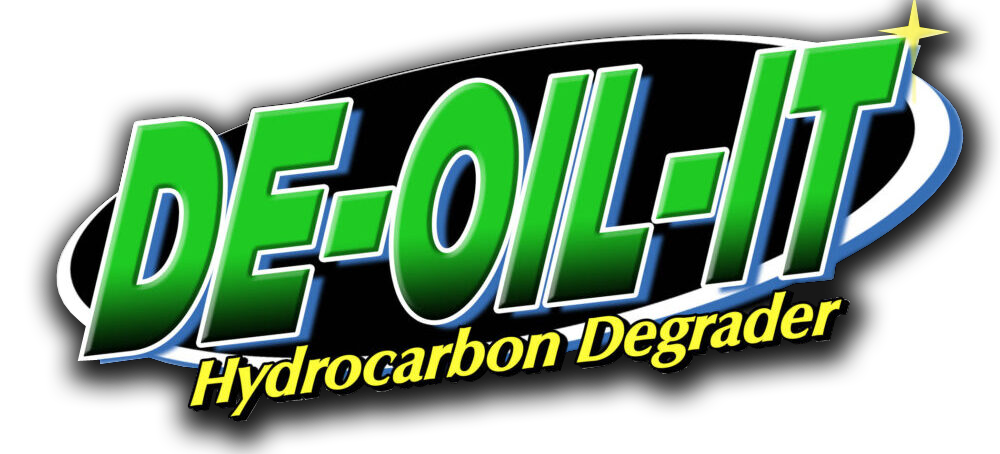
Métodos de limpieza sin aceite
Power Washing
Para la limpieza de equipos pesados, como equipos de construcción, trenes, contenedores de 40 pies, etc., lo más probable es que sea necesario utilizar una lavadora a presión o eléctrica.
Power washing using 95-105 degrees Fahrenheit water is preferred when creating your cleaning solution (De-Oil-It Industrial Strength Concentrate – “ISC” mixed with water). We recommend rinsing or power/pressure washing the surface to remove as much particulate matter as possible, then apply De-Oil-It cleaning solution (De-Oil-It and water), and soak for 15 minutes before power washing (using hot water) or pressure washing (which typically uses available non-heated water sources). During the soaking phase, you might need to agitate with a brush to mix in the cleaning solution to the dirty areas especially if caked with sludge (however the action from the pressure/power washer is sufficient in most cases). Rinse thoroughly, and repeat until desired results are obtained.
We recommend a 1:1 solution of De-Oil-It ISC plus the equivalent measure of water for very dirty surfaces (perhaps caked with sludge, oil, or hydraulic fluids that have leaked and caked with dirt). Or you can effectively clean heavy-duty equipment surfaces with a 4:1 solution (4 parts water, and 1 part De-Oil-It). The most concentrated cleaning solution we recommend is 1:3, meaning 1 part water, and 3 parts De-Oil-It).
NO USE ISC (Concentrado de Fuerza Industrial De-Oil-It) solo; De-Oil-It requiere agua en la solución de limpieza; No se recomienda simplemente rociar el concentrado seguido de un lavado a presión. La única aplicación de limpieza en la que se utilizaría ISC por sí solo es si un grupo medioambiental acreditado, como la EPA, permite que De-Oil-It contenga derrames de petróleo en el agua; en este caso, rodearía el derrame de petróleo con ISC, lo que evitará y ralentizará significativamente la propagación del derrame de petróleo.
Oil Remediation
Comuníquese con nosotros en mddigital@mdenterprisesok.com para que podamos brindarle la metodología recomendada utilizando uno de dos procedimientos; el primero es para contaminación del suelo hasta 2 pies de profundidad; el segundo es limpiar la contaminación del suelo a más de 2 pies de profundidad.
Este sistema probado ha reducido la limpieza del suelo con remediación convencional con petróleo de aproximadamente 3 a 4 meses a aproximadamente 4 a 6 semanas utilizando una gama de 3 a 8 aplicaciones.
Estacionamientos
Es necesario calcular la cobertura en pies cuadrados de todo el estacionamiento. Recomendamos DRAFTLOGIC, ya que esta herramienta utiliza Google Earth para que pueda ver visualmente la superficie que está midiendo con herramientas relativamente fáciles de usar para crear zonas y luego sumar la cobertura neta de pies cuadrados de todas las zonas.
Al lavar áreas pequeñas de pies cuadrados, como entradas de vehículos, es mejor usar una bomba de 1,5 a 5 galones o un rociador asistido eléctricamente con una presión de 20 a 25 psi. Rocíe una fina capa de DOI sobre la superficie, déjela en remojo durante 15 minutos y posiblemente agite con una escoba para aplicar el DOI en las manchas. En su mayor parte, podría ser más fácil usar la botella rociadora de 32 onzas para rociar 3 bombas directamente sobre una fuga de aceite en el camino de entrada y aplicar una capa directamente sobre y alrededor de la mancha/derrame; pero dependiendo de qué tan grande sea o si desea lavar todo el camino de entrada. Si ese es el caso, use un rociador de 1,5, 2, 2,5 o 5 galones que rocíe de manera más uniforme y con menos esfuerzo que apretar una botella rociadora de 32 onzas. Agregar RTU directamente a un rociador de 1,5 a 5 galones está bien; no es necesario diluir más. Si el camino de entrada necesita una limpieza intensa, entonces se requieren múltiples aplicaciones usando RTU. Alternativamente, se puede utilizar ISC para crear una solución de limpieza de alta resistencia 1:1; todo depende de qué tan oscuras sean las manchas; si el hormigón está especialmente sucio debido a su naturaleza porosa, y si el calcio del cemento se une fuertemente al aceite, lo que dificulta la limpieza.
Limpieza general
Examples are countertop cleaning, laundry pre-soak, wheel rims, engine cleaning, boat bilge treatment, and other such surfaces.
We recommend our 32-ounce spray bottle, Ready-to-Use (RTU) formula.
Rocíe a una distancia de 6 a 12 pulgadas, usando 2-3 bombas; esto creará un círculo de De-Oil-It de aproximadamente 6 pulgadas. Déjelo en remojo durante unos minutos y luego límpielo.
For heavy-duty applications such as degreasing wheel rims, engines, and boat bilges we recommend 10-15 minutes of soaking time before rinsing with water.
When cleaning glass we recommend spraying, wiping, and rinsing; do not soak De-Oil-It on glass surfaces for more than a few minutes or it will possibly “etch” the glass.
Limpieza de cubetas
Para limpiar pisos, use 2 tapones del recipiente De-Oil-It de 1 galón (o de 2,5 galones); Si usa una botella rociadora de 32 onzas, rocíe de 3 a 4 veces en el fondo del balde antes de agregar agua (aproximadamente 2 a 2,5 galones de agua).
Puede esperar poder limpiar entre 400 y 600 pies cuadrados de la superficie del piso. Recomendamos crear zonas para que no exceda más de 400 a 600 pies cuadrados. Cambie el agua y De-Oil-It antes de limpiar la siguiente “zona”.
For cleaning cars, boats, etc. use 1-2 capfuls of De-Oil-It in the bottom of a clean bucket, then fill with water. Using a sponge, clean rag or soft brush liberally apply the De-Oil-It and water cleaning solution. Scrub as necessary to remove dirt and grime; rinse thoroughly.
Selecting between light, medium, and heavy-duty cleaning of large surface areas
Light duty cleaning: is meant for the regularly scheduled cleaning of large square foot surfaces after the initial more concentrated cleaning solutions are utilized. This will accomplish surface area cleanliness which can be maintained along with environmental preservation. Light duty cleaning will continually degrade hydrocarbons that have been built up in the past and are continuously added to the environment. Light duty cleaning is formulated with Florida EPA in mind, meaning the 30:1 ratio is what is allowed to be used for water runoff into grasses, water and storm drains.
Medium duty cleaning: is meant to be the starting point for regularly scheduled cleaning tasks (such as every two weeks or once a month, for example). Along with input from professional pressure washer groups already using DOI, Medium duty cleaning is good for the first 3 cleaning tasks; this seems to alleviate stains in concrete or at least reduce to the least visibility possible. Medium duty cleaning is a ratio of 4:1 which is exactly RTU.
Heavy duty cleaning: is used for all visible spills of oil, gas, diesel, etc. on surfaces and/or for dark stains. A ratio of 1:1 works well for a first-time cleaning if the area has a lot of visible standing oil, fuel, or dark stains. Deciding if an area needs heavy duty cleaning is all about observation; if it looks bad, then treat it in the most vigorous way possible but never Industrial Strength without dilution which is the ISC “cleaning solution” (H2O: DOI).
Steps To Follow
Once you have determined your level of cleaning, follow these steps to calculate the ratio of water to De-Oil-It needed to create your cleaning solution:
Calcule la medida en pies cuadrados del estacionamiento, estacionamiento o área del muelle.
Decida la concentración de la solución de limpieza: trabajo pesado, trabajo medio, trabajo liviano. (Ver sección anterior)
Heavy Duty = 1:1 water to DOI-ISC; this dilution = “De-Grease-It”. Medium Duty = 4:1 water to DOI-RTU. Light Duty = 30:1 water to DOI-ISC
Crear solución de limpieza
Heavy Duty-SqFt * 0.0776 = gallons of cleaning solution. Gallons of cleaning solution * 0.50 = amount of DOI-ISC. Add H2Oto the remainder of the cleaning solution.
Medium Duty-SqFt * 0.0389 = gallons of cleaning solution. Gallons of cleaning solution * 0.20 = amount of DOI-ISC. Add H2O to the remainder of the cleaning solution.
Servicio liviano-pies cuadrados * 0.0194 = galones de solución de limpieza. Galones de solución limpiadora * 0,03 = cantidad de DOI-ISC. Agregue H2O al resto de la solución limpiadora.
Prelimpiar la superficie a lavar. Esto puede hacerse con una escoba, pero la mayoría de las lavadoras a presión limpian la superficie con una manguera para eliminar las partículas (suciedad, guijarros, etc.); esto también ayuda a agregar humedad al área que se está limpiando.
Apply cleaning solution by a sprayer onto the surface, and allow to soak for 15 minutes. This will most likely be much easier using a sprayer that can deliver 20-25 psi minimally (higher is ok but not always necessary). Spray the cleaning solution onto the surface, soak for 15 minutes, and possibly agitate using a broom for stubborn stains.
Rinse. A pressure washer can be utilized for this step. In some cases pressure washing groups have added a couple of cup-fills of De-Oil-It to the soap container on the pressure washer; this isn’t mandatory but in some cases, if the surface is really dirty this isn’t a bad idea, it just requires more time and effort to rinse.
Observe. Observation can help determine if another application is required or not until the next cleaning cycle. In large remediation projects on soil at this step, hydrocarbon measurement dictates applying another cleaning solution.
¿Por qué optar por De-Oil-It de M&D?
580-886-2345
info@mowersok.com
Woodward, Weatherford,
Vela y Cantón
Oklahoma
Césped y jardín
Backyard Essentials
Almacenamiento y seguridad
Productos de caza
What is M&D?
Todos los derechos reservados | Empresas M&D



